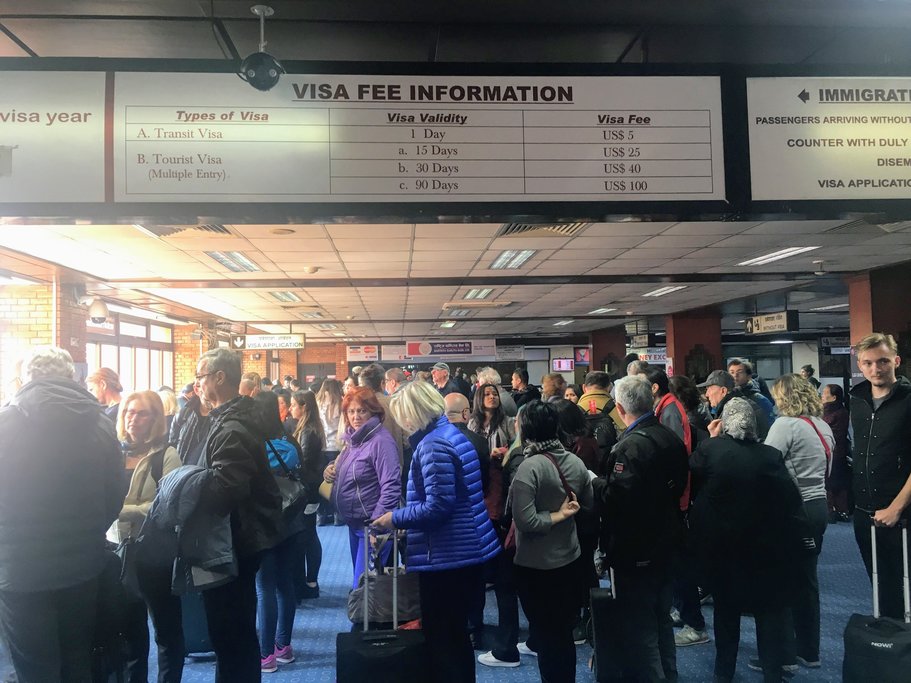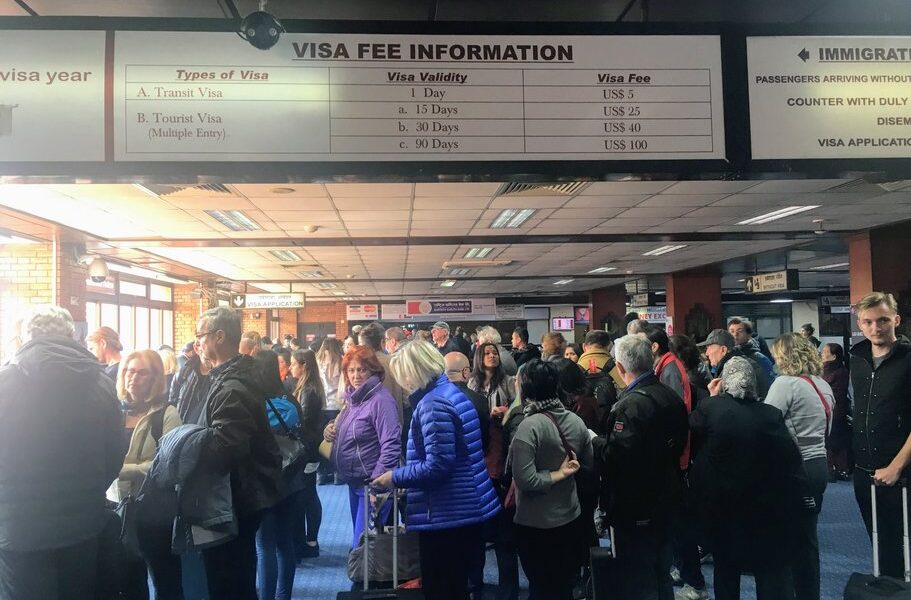
Heading to Nepal? Everyone needs a visa (except Indian nationals), but luckily it’s an easy process. Here’s the latest information on obtaining a tourist visa and how it works for visa-on-arrival (the easiest way to get your tourist visa).
## Obtaining Your Visa for Nepal: A Comprehensive Guide
Planning a trip to the breathtaking landscapes and vibrant culture of Nepal? One of the first steps is securing your visa. This guide provides detailed information on the various ways to obtain your visa, ensuring a smooth start to your Nepalese adventure.
## Getting Your Visa-On-Arrival
Upon arrival at Tribhuvan International Airport in Kathmandu, you’ll find a convenient system for obtaining your visa directly. Inside the arrivals hall, you’ll notice a series of **electronic kiosks** designed to streamline the application process. These kiosks are user-friendly, equipped to read your passport information, capture your photograph, and automatically print out a completed visa application form. This eliminates the need for manual form filling, saving you valuable time.
Once you have your completed form in hand, proceed to the payment counter located nearby. Here, you’ll pay the necessary visa fee. After making your payment, make your way to the designated immigration line specifically marked for “Visa on Arrival”. Be prepared to present your passport, completed form, and payment receipt to the immigration officer.
**To ensure a swift and efficient process, be sure to have the following items readily accessible:**
* Cash to pay the visa fee. United States Dollars (USD) are the preferred currency, particularly at land border crossings. However, you can also make payments using Euros (EUR), Swiss Francs (CHF), British Pounds (GBP), Australian Dollars (AUD), Canadian Dollars (CAD), Hong Kong Dollars (HKD), Singapore Dollars (SGD), and Japanese Yen (JPY).
* A passport that remains valid for a minimum of six months from your intended date of entry into Nepal. This is a crucial requirement, so double-check your passport’s expiration date before you travel.
* It is important to note that certain nationalities are unfortunately not eligible to obtain a visa-on-arrival. Citizens of the following countries cannot obtain a visa on arrival: Afghanistan (AFG), Iraq (IRQ), Cameroon (CMR), Ghana (GHA), Somalia (SOM), Swaziland (SWZ), Palestine (PSE), Zimbabwe (ZWE), Nigeria (NGA), Ethiopia (ETH), and Liberia (LBR). If you hold a passport from one of these countries, you must apply for a visa in advance through a Nepali embassy or consulate.
### Expert Tips for a Smooth Arrival
To further expedite your visa-on-arrival experience, consider these valuable tips:
* Fill out your disembarkation card while you’re still on the plane. This small act will save you time upon arrival and allow you to move through the initial queue more quickly.
* Consider completing the visa application form online before you arrive. While there are electronic kiosks available, their number is limited. Completing the form online beforehand can significantly reduce your waiting time.
* Ask your hotel or your KimKim specialist for the most accurate and up-to-date address details. This information is often required on the visa application form but can be difficult to find independently.
## Getting Your Visa Online
Since 2014, the Nepalese government has offered the option of applying for a tourist visa online. This convenient option allows you to begin the visa process from the comfort of your own home, up to 15 days prior to your intended date of arrival in Nepal.
To apply online, you’ll need the address of your hotel or intended accommodation in Nepal. You’ll also need a recent digital version of a passport-sized photograph. This photo will need to be uploaded as part of the online application process.
Once you’ve completed the online form and submitted it, be sure to print out the confirmation receipt. This receipt serves as proof of your application and will be required upon arrival. Upon arrival, present your passport and the confirmation receipt to the immigration officer. Be prepared to also pay the appropriate visa fee.
## Getting Your Visa at a Nepali Embassy
An alternative to obtaining your visa on arrival or online is to apply in advance through a Nepali embassy or consulate. This option offers the peace of mind of having your visa secured before you even begin your journey. To apply, visit the local Nepali Embassy or consulate in your home country, or mail your application to them well in advance of your departure date.
## Getting Your Visa at a Land Border Crossing
For travelers entering Nepal via land, Immigration Offices are located at all border crossings that are open to foreign nationals. You’ll be able to apply for and receive a visa at these land border crossings, as well.
## Price & Duration
The price of your visa depends on the intended duration of your stay. There are three options available for tourist visas:
| Duration of Stay | Price |
| —————- | ——– |
| 15 days | $30 USD |
| 30 days | $50 USD |
| 90 days | $125 USD |
| Multiple Entry | $25 USD |
Note that for nationals of SAARC countries, the first 30 days of their stay are visa-free. A Multiple Entry visa costing $25 USD is useful for those planning to travel back-and-forth between Tibet and India during their trip.
## Extending Your Visa
If you find yourself wanting to extend your stay in Nepal, you can extend your visa for up to a maximum of 150 days. To do so, visit the Immigration Department offices in Kathmandu or Pokhara. The extension process typically takes one day to complete. You’ll need to submit your passport, the extension fee (currently $30 for 15 days and $2 per day thereafter), one passport-sized photograph, and the completed application extension form.
## Additional Expert Tips
To make your visa application and overall travel experience even smoother, consider these additional expert tips:
* It’s always a good idea to bring a few extra passport photos from home, ideally 4-5. These can come in handy for various official documents or for purchasing local sim cards.
* Kathmandu’s airport provides convenient bank counters where you can exchange your currency for Nepalese Rupees.
* Carrying a couple of photocopies of your passport is always a smart travel practice. These copies can be useful in case your original passport is lost or stolen.
* While there are now various payment methods available at the airport, including the visa application kiosks, malfunctions can sometimes occur. Therefore, it’s strongly recommended that you carry the correct amount of money in cash (US Dollars are recommended) and a passport photo with you, just in case.
By following this comprehensive guide, you’ll be well-prepared to navigate the visa application process and begin your unforgettable journey in Nepal.
B-1822

